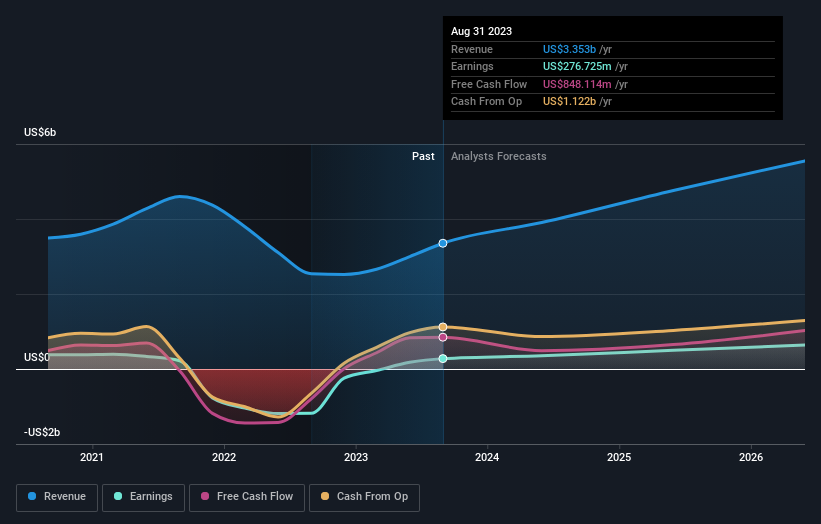- United States
- /
- Consumer Services
- /
- NYSE:EDU
New Oriental Education & Technology Group Inc.'s (NYSE:EDU) large institutional owners must be happy as stock continues to impress, up 5.2% over the past week

Key Insights
- Institutions' substantial holdings in New Oriental Education & Technology Group implies that they have significant influence over the company's share price
- The top 14 shareholders own 50% of the company
- 12% of New Oriental Education & Technology Group is held by insiders
To get a sense of who is truly in control of New Oriental Education & Technology Group Inc. (NYSE:EDU), it is important to understand the ownership structure of the business. With 66% stake, institutions possess the maximum shares in the company. That is, the group stands to benefit the most if the stock rises (or lose the most if there is a downturn).
Last week’s 5.2% gain means that institutional investors were on the positive end of the spectrum even as the company has shown strong longer-term trends. The one-year return on investment is currently 99% and last week's gain would have been more than welcomed.
Let's take a closer look to see what the different types of shareholders can tell us about New Oriental Education & Technology Group.
View our latest analysis for New Oriental Education & Technology Group

What Does The Institutional Ownership Tell Us About New Oriental Education & Technology Group?
Many institutions measure their performance against an index that approximates the local market. So they usually pay more attention to companies that are included in major indices.
New Oriental Education & Technology Group already has institutions on the share registry. Indeed, they own a respectable stake in the company. This can indicate that the company has a certain degree of credibility in the investment community. However, it is best to be wary of relying on the supposed validation that comes with institutional investors. They too, get it wrong sometimes. When multiple institutions own a stock, there's always a risk that they are in a 'crowded trade'. When such a trade goes wrong, multiple parties may compete to sell stock fast. This risk is higher in a company without a history of growth. You can see New Oriental Education & Technology Group's historic earnings and revenue below, but keep in mind there's always more to the story.

Institutional investors own over 50% of the company, so together than can probably strongly influence board decisions. New Oriental Education & Technology Group is not owned by hedge funds. Because actions speak louder than words, we consider it a good sign when insiders own a significant stake in a company. In New Oriental Education & Technology Group's case, its Top Key Executive, Minhong Yu, is the largest shareholder, holding 12% of shares outstanding. With 9.1% and 5.1% of the shares outstanding respectively, FMR LLC and Norges Bank Investment Management are the second and third largest shareholders.
A closer look at our ownership figures suggests that the top 14 shareholders have a combined ownership of 50% implying that no single shareholder has a majority.
While it makes sense to study institutional ownership data for a company, it also makes sense to study analyst sentiments to know which way the wind is blowing. There are a reasonable number of analysts covering the stock, so it might be useful to find out their aggregate view on the future.
Insider Ownership Of New Oriental Education & Technology Group
While the precise definition of an insider can be subjective, almost everyone considers board members to be insiders. Management ultimately answers to the board. However, it is not uncommon for managers to be executive board members, especially if they are a founder or the CEO.
Most consider insider ownership a positive because it can indicate the board is well aligned with other shareholders. However, on some occasions too much power is concentrated within this group.
It seems insiders own a significant proportion of New Oriental Education & Technology Group Inc.. It is very interesting to see that insiders have a meaningful US$1.5b stake in this US$12b business. It is good to see this level of investment. You can check here to see if those insiders have been buying recently.
General Public Ownership
The general public, who are usually individual investors, hold a 21% stake in New Oriental Education & Technology Group. This size of ownership, while considerable, may not be enough to change company policy if the decision is not in sync with other large shareholders.
Next Steps:
I find it very interesting to look at who exactly owns a company. But to truly gain insight, we need to consider other information, too.
Many find it useful to take an in depth look at how a company has performed in the past. You can access this detailed graph of past earnings, revenue and cash flow.
If you are like me, you may want to think about whether this company will grow or shrink. Luckily, you can check this free report showing analyst forecasts for its future.
NB: Figures in this article are calculated using data from the last twelve months, which refer to the 12-month period ending on the last date of the month the financial statement is dated. This may not be consistent with full year annual report figures.
Valuation is complex, but we're here to simplify it.
Discover if New Oriental Education & Technology Group might be undervalued or overvalued with our detailed analysis, featuring fair value estimates, potential risks, dividends, insider trades, and its financial condition.
Access Free AnalysisHave feedback on this article? Concerned about the content? Get in touch with us directly. Alternatively, email editorial-team (at) simplywallst.com.
This article by Simply Wall St is general in nature. We provide commentary based on historical data and analyst forecasts only using an unbiased methodology and our articles are not intended to be financial advice. It does not constitute a recommendation to buy or sell any stock, and does not take account of your objectives, or your financial situation. We aim to bring you long-term focused analysis driven by fundamental data. Note that our analysis may not factor in the latest price-sensitive company announcements or qualitative material. Simply Wall St has no position in any stocks mentioned.
About NYSE:EDU
New Oriental Education & Technology Group
New Oriental Education & Technology Group Inc.
Flawless balance sheet and good value.
Similar Companies
Market Insights
Community Narratives



